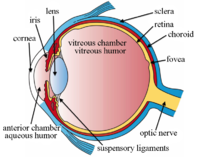
Photo from wikipedia
Background: In the care of open fractures, time to antibiotic administration has been shown to be a critical factor in preventing infection. To help improve outcomes at our institution we… Click to show full abstract
Background: In the care of open fractures, time to antibiotic administration has been shown to be a critical factor in preventing infection. To help improve outcomes at our institution we designed and implemented an open fracture pathway with the goal of reducing the time from emergency department (ED) arrival to antibiotic administration. Here we evaluate the success of this pathway, propose improvements in the protocol, and provide a framework for initiation at other institutions. Methods: We compared a retrospective prepathway cohort with a prospective postpathway cohort for 1-year pre and postpathway implementation. First, we analyzed the number of patients from outside facilities who had received antibiotics before transfer. For patients who had not received antibiotics before arriving at our institution, we reviewed pathway metrics including time from ED arrival to the ordering and administration of antibiotics, whether the correct antibiotic type was selected, and time to surgical debridement. Results: There were 50 patients in the prepathway cohort and 29 in the postpathway cohort. Prepathway 60.5% of transfers (23 of 38) received antibiotics before transfer, whereas post-pathway 90.0% of transfers (18 of 20) received antibiotics (P=0.032). For patients who had not received antibiotics before arriving at our institution and were included in pathway metric analysis, there were no differences in demographics or fracture characteristics. Time from ED arrival to antibiotic order decreased from 115.3 to 63.5 minutes (P=0.016). Time from antibiotic order to administration was similar between groups (48.0 vs. 35.7 min, P=0.191), but the overall time from ED arrival to antibiotic administration decreased from 163.3 to 99.2 minutes (P=0.004). There were no significant differences in whether the correct antibiotic type was chosen (P=0.354) or time from ED arrival to surgery (P=0.783). Conclusions: This study provides evidence that for pediatric patients presenting with open fractures, a care pathway can successfully decrease the time from ED arrival to antibiotic administration. Level of Evidence: Therapeutic level III—retrospective comparative study.
Journal Title: Journal of Pediatric Orthopaedics
Year Published: 2022
Link to full text (if available)
Share on Social Media: Sign Up to like & get
recommendations!